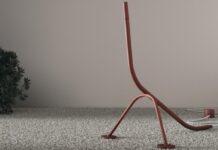Launched 44 years ago, the Alape EW3 model was a revolutionary basin and still an icon in bathroom design today. With its compact, round shape, and immaculate white glaze, EW3 was originally designed as a built-in basin for washstand surfaces. It was the first industrially-produced basin of its kind, and its visionary design, which eliminated the need of a separate ceramic basin, marked a revolution in bathroom architecture. The Alape EW3 basin became incredibly popular as it fitted perfectly in smaller homes.
 The first “breakthrough happened in the 1970s – a time of outrageous experimentation, innovative concepts and cultural exploration. In this exciting and unpredictable period,the EW3 basin was a product ahead of its time; it bore a resemblance to objects produced in the Bauhaus period, with its purist and geometrically formed design and defined silhouette, The EW 3 was also extremely functional and used enamel, a superior material compared to the bright plastics so popular in the 70s.
The first “breakthrough happened in the 1970s – a time of outrageous experimentation, innovative concepts and cultural exploration. In this exciting and unpredictable period,the EW3 basin was a product ahead of its time; it bore a resemblance to objects produced in the Bauhaus period, with its purist and geometrically formed design and defined silhouette, The EW 3 was also extremely functional and used enamel, a superior material compared to the bright plastics so popular in the 70s.
 The EW 3 captured the spirit of the time, and was something completely new. What made it stand out was the fact that this product didn’t just satisfy a temporary trend, but initiated a new development for the private and semi-public sanitary sectors. The basin’s circular exterior, with its typically kidney-shaped bowl, is intended for use with a single lever tap to sit on its edge.
The EW 3 captured the spirit of the time, and was something completely new. What made it stand out was the fact that this product didn’t just satisfy a temporary trend, but initiated a new development for the private and semi-public sanitary sectors. The basin’s circular exterior, with its typically kidney-shaped bowl, is intended for use with a single lever tap to sit on its edge.
 By the 1990s it had evolved into a range of more than 25 models, which were available in numerous different shapes and diameters. The basins were available in a spectrum of standard European colours and special Alape colours, from soft Bahama beige to a rich red and lustrous blue.
By the 1990s it had evolved into a range of more than 25 models, which were available in numerous different shapes and diameters. The basins were available in a spectrum of standard European colours and special Alape colours, from soft Bahama beige to a rich red and lustrous blue.
 Within just a few years, Alape developed into one of the most valued brands on the market and became well known among architects. In the decades to follow, Alape managed to regularly launch innovative and trend-setting products, for all areas of the washplace. To some extent, the modern furniture washstand at the core of the bathroom is also an Alape innovation.
Within just a few years, Alape developed into one of the most valued brands on the market and became well known among architects. In the decades to follow, Alape managed to regularly launch innovative and trend-setting products, for all areas of the washplace. To some extent, the modern furniture washstand at the core of the bathroom is also an Alape innovation.
Alape was founded in 1896 by Adolf Lamprecht in Penig, Germany, as an enamel products operation. Today, the company with its more than 200 employees at two production sites in Goslar, Germany, produces esthetic washplace solutions for the private and semi-public sectors. As a manufacturer, Alape stands for technically functional quality standards and inspiring design. Glassed steel in combination with a variety of high-quality materials allows Alape’s individual designs for an environment with an architectural legacy.
For more information visit alape.com




























